Vought F7U Cutlass Video - Overview
|
|
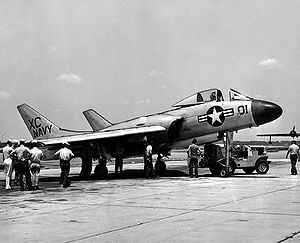
Picture - An F7U-3 Cutlass on the ramp at Naval Air Station Jacksonville.
Role: Naval multirole fighter
Manufacturer: Chance Vought
First flight: 29 September 1948
Introduced: July 1951
Retired: 2 March 1959
Primary user: United States Navy
Produced: 1948-1955
Number built: 320
The Vought F7U Cutlass was a United States Navy carrier-based jet fighter and fighter-bomber of the early Cold War era. It was a highly unusual, semi-tailless design, allegedly based on aerodynamic data and plans captured from the Arado company at the end of World War II, though Vought designers denied any link to the German research at the time. The F7U was the last aircraft designed by Rex Beisel, who was responsible for the first fighter ever designed specifically for the US Navy, the Curtiss TS-1 of 1922.
Regarded as a radical departure from traditional aircraft design, the Cutlass suffered from numerous technical and handling problems throughout its short service career. The type was responsible for the deaths of four test pilots and 21 other U.S. Navy pilots. Over one quarter of all Cutlasses built were destroyed in accidents. The poor safety record was largely the result of the advanced design built to apply new aerodynamic theories and insufficiently powerful, unreliable engines.
Design and development
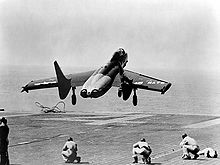
Picture - The first F7U-1 launching from the USS Midway in 1951
The Cutlass was Vought's entry to a U.S. Navy competition for a new carrier capable day fighter opened on 1 June 1945. The requirements were for an aircraft that was able to fly at 600 mph (966 km/h) at 40,000 ft (12,192 m). The design featured broad chord, low aspect ratio, swept wings, with twin wing-mounted tail fins either side of a short fuselage. The cockpit was situated well forward to provide good visibility for the pilot during aircraft carrier approaches. The design was given the company type number of V-346 and then the designation F7U when it was announced the winner of the competition.
Pitch and roll control was provided by elevons, though Vought called these surfaces "ailevators" at the time. Slats were fitted to the entire span of the leading edge. All controls were hydraulically-powered. The very long nose landing gear strut required for high angle of attack takeoffs was rather weak, and a collapse could seriously jeopardize the pilot's safety. The F7U was also largely let down by its underpowered Westinghouse turbojets, an engine which some pilots wryly observed put out less heat than the same company's toasters. Naval aviators referred to the F7U as the "gutless cutlass" or, in kinder moments, as the "praying mantis".
Operational history
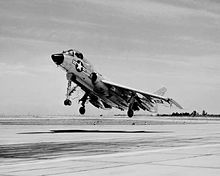
Picture - Vought F7U-3 Cutlass
![Airplane Picture - Ramp strike of a VF-124 F7U-3 on the USS Hancock on 14 July 1955 resulting in the deaths of the pilot, two boatswain's mates and a photographers mate. [3]](images/vought-f7u-cutlass/220px-F7U-3_CVA-19_ramp_strike_1955.jpg)
Picture - Ramp strike of a VF-124 F7U-3 on the USS Hancock on 14 July 1955 resulting in the deaths of the pilot, two boatswain's mates and a photographers mate. [3]
Three prototypes were ordered in 1946, with the first example flying on 29 September 1948, piloted by Vought's Chief Test Pilot, J. Robert Baker. The maiden flight took place from Naval Air Station Patuxent River and was not without its problems. During testing one of the protypes reached a maximum speed of 625 mph (1,058 km/h)
Production orders were placed for the F7U-1 in a specification very close to the prototypes, and further developed F7U-2 and F7U-3 versions with more powerful engines. Because of development problems with the powerplant, however, the F7U-2 would never be built, while the F7U-3 would incorporate many refinements suggested by tests of the -1. The first 16 F7U-3s had non-afterburning Allison J35-29 engines. The -3 with its Westinghouse J46-WE-8B turbojets would eventually become the definitive production version, with 288 aircraft equipping 13 U.S. Navy squadrons. Further development stopped once the F8U Crusader flew.
The F7U bore the fleet nickname of the Gutless Cutlass in reference to its lack of engine thrust; consequently its carrier landing and takeoff performance was notoriously poor. The J35 was actually known to flameout in the rain, a very serious fault.
The first fleet squadron to receive F7Us was VF-81 in April 1954; the last with Cutlasses was VA-66 in November 1957. Few squadrons made deployments with the type, and most "beached" them during part of the cruise owing to operating difficulties. Those units known to have taken the type to sea were:
VF-124, USS Hancock (CVA-19), August 1955 - March 1956; VF-81, USS Ticonderoga (CVA-14), November 1955 - August 1956; VF-86, USS Forrestal (CVA-59), January - March 1956; VF-83, USS Intrepid (CVA-11), March - September 1956; VF-212, USS Bon Homme Richard (CVA-31), August 1956 - February 1957.
VC-3 and VX-4 also operated Cutlasses at sea for evaluation purposes.
Blue Angels
The Blue Angels Navy aerobatics team flew two F7U-1 Cutlasses as a side act during their 1953 show season in an effort to promote the new aircraft, but did not use them as part of their regular formation act. Both the pilots and ground crews found the aircraft generally unsatisfactory and it was apparent that the type was still experiencing teething troubles.
During the Blue Angel's first airshow appearance in 1953 pilot Edward "Whitey" Feightner, the former program manager for the F7U, experienced a total loss of hydraulics on a full afterburner takeoff and steep climb. While trying to gain enough altitude for ejection he was able to stay with the aircraft until the back up system came on. He clipped trees on the end of the runway, causing the left engine to flame out. With hydraulic fluid streaming back in a bright flame, he made a hard turn and got the plane back on the runway, much to the excitement of the crowd. Later, while traveling to the airshow at Glenview Airport in Chicago, Blue Angel's pilot Lt Harding MacKnight, experienced an engine flameout in his Cutlass, forcing him to make an emergency landing at Glenview. Traveling with him, "Whitey" Feightner was redirected to make his landing at Chicago's former Orchard Airpark, which had been expanded and renamed O'Hare Airport. The runway had just been completed and was covered with peach baskets to prevent aircraft from landing until it was opened. Lt. Feightner was told to ignore the baskets and land on the new runway. As a result, LT Feightner's F7U became the first aircraft to land on the new runway for Chicago's O'Hare Airport.
Following these incidents the two F7U were deemed unsuitable for demonstration flying and were flown to Naval Air Station Memphis, where they were abandoned to become aircraft maintenance instructional airframes for the Naval Technical Training Center.
Variants
XF7U-1 Three prototypes ordered on 25 June 1946. First flight, 29 September 1948, all three aircraft were destroyed in crashes. F7U-1 The initial production version, 14 built. Powered by two J34-WE-32 engines. F7U-2 Proposed version, planned to be powered by two Westinghouse J34-WE-42 engines with afterburner, but the order for 88 aircraft was cancelled. XF7U-3 Designation given to one aircraft built as the prototype for the F7U-3. First flight: 20 December 1951. F7U-3 The definitive production version, 192 built.
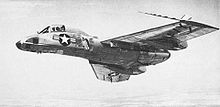
Picture - F7U-3P reconnaissance aircraft
F7U-3P Photo-reconnaissance version, 12 built. With a 25 in longer nose and equipped with photo flash cartridges none of these aircraft saw operational service, being used only for research and evaluation purposes. F7U-3M This version was armed with the AIM-7 Sparrow air-to-air missile, 98 built. A total of 48 F7U-3 existing airframes were upgraded to F7U-3M standard. An order for 202 aircraft was cancelled. A2U-1 Designation given to a cancelled order of 250 aircraft to be used in the ground attack role.
Operators
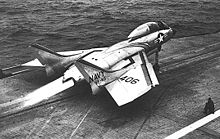
Picture - A VF-83 F7U-3M launches from the USS Intrepid in 1954
United States
United States Navy
VA-12
VA-34
VA-35
VA-66
VA-83
VA-86
VA-116
Composite Squadron 3 (VC-3)
VF-124
VA-126**VA-155**VF-83
VF-81
VF-84
VF-122
VF-151
VF-212
Text and Evaluation Squadron 4 (VX-4)
United States Navy
Survivors
Seven F7U Cutlass aircraft are known to have survived.
F7U-3 BuNo 128451 Formerly at the Fred E. Weisbroad Aviation Museum/International B-24 Museum in Pueblo, Colorado. It was unrestored and incomplete, in poor condition. It is now at USS Midway (CV-41) Museum in San Diego, California, to be combined with BuNo 129565 to make one complete aircraft. F7U-3 BuNo 129554 Purchased by Len Berryman from Geiger Field, Washington in May 1958 and displayed outside the Berryman War Memorial Park in Bridgeport, Washington from 1958 until 1992. In June 1992 it was sold to Tom Cathcart of Ephrata, Washington for restoration to eventual flying condition. This aircraft is currently undergoing restoration at the Museum of Flight in Everett, Washington. F7U-3 BuNo 129565 Was undergoing restoration for display at the USS Hornet (CV-12) Museum at the former NAS Alameda in Alameda, California. Has now been transferred to USS Midway (CV-41) Museum in San Diego, California for final restoration and display. F7U-3 BuNo 129622 Ex VA-12 aircraft crash-landed at NAS Glenview and was dissected and sold for its engines. Forward fuselage was part of Earl Reinarts collection in Mundelein, Il, while the rest of the aircraft went to J-46 dragster builder Fred Sibley. Its components are currently reunited in the collection of noted F7U historian Al Casby of Phoenix, AZ. F7U-3 BuNo 129642 On display at the Wings of Freedom Aviation Museum at the Naval Air Station Joint Reserve Base Willow Grove, Pennsylvania. The aircraft belonged to Attack Squadron 12 (VA-12} and was flown to NAS Willow Grove in May 1957 to take part in an air show. Upon arrival the aircraft was stricken from active duty. It was given to the Navy Reserve as a ground training aircraft, and eventually placed as a gate guard in front of the base on US Route 611. The airframe has only 326.3 hours total time.
Picture - F7U-3M at the National Museum of Naval Aviation at NAS Pensacola, Florida
F7U-3 BuNo 129655 Although marked as an F7U-3M, this aircraft on display at the National Museum of Naval Aviation in Pensacola, Florida is in reality an F7U-3. Formerly displayed at Griffith Park, California. F7U-3 BuNo 129685 Located for many years at the aircraft collection of Walter Soplata in Newbury, Ohio. Like most aircraft on this famous farm the aircraft appears complete, though it is exposed to the elements and unrestored.
Specifications (F7U-3M)
Data from Jane's Encyclopedia of Aviation
General characteristics
Crew: 1
Length: 44 ft 3 in (13.49 m)
Wingspan: 38 ft 8 in (11.79 m)
Height: 14 ft 0 in (4.27 m)
Wing area: 496 ft² (46.1 m²)
Empty weight: 18,210 lb (8,260 kg)
Max takeoff weight: 31,642 lb (14,353 kg)
Powerplant: 2x— Westinghouse J46-WE-8A turbojets, 4,600 lbf (20.46 kN) each
Performance
Maximum speed:
Clean: 680 mph (590 kn, 1,095 km/h)
With missiles: 648 mph (562 kn, 1,040 km/h)
Range: 660 mi (570 nmi, 1,060 km)
Service ceiling: 40,000 ft (12,000 m)
Rate of climb: 13,000 ft/min (67 m/s)
Wing loading: 64 lb/ft² (312 kg/m²)
Thrust/weight: 0.29
Armament
Guns: 4x— 20 mm (0.787 in) M3 cannons above inlet ducts, 180 rounds/gun
Hardpoints: 4 with a capacity of 5,500 lb (2,500 kg) and provisions to carry combinations of:
Missiles: AIM-7 Sparrow air-to-air missiles
Comparable aircraft
A-7 Corsair
F-8 Crusader
F4D Skyray
Bibliography
Angelucci, Enzo. The American Fighter. Sparkford, Somerset, UK: Haynes Publishing Group, 1987. ISBN 0-85429-635-2.
Ginter, Steve. Chance Vought F7U Cutlass (Naval Fighters Number Six). Simi Valley, California: Ginter Books, 1982. ISBN 0-942612-06-X.
Green, William and Gerald Pollinger. The Aircraft of the World. London: Macdonald, 1955.
Gunston, Bill. Fighters of the Fifties. Cambridge, UK: Patrick Stephens Limited, 1981. ISBN 0-85059-463-4.
Powell, R.R. "Boom". "Cutlass Tales". Flight Journal, Volume 13, Issue 4, August 2008.
Taylor, John W. R. "Vought F7U Cutlass". Combat Aircraft of the World from 1909 to the Present. New York: G.P. Putnam's Sons, 1969. ISBN 0-425-03633-2.
Taylor, Michael J.H., ed. "Chance Vought F7U Cutlass". Jane’s Encyclopedia of Aviation. New York: Crescent, 1993. ISBN 0-517-10316-8.
Winchester, Jim, ed. "Vought F7U Cutlass". The World's Worst Aircraft: From Pioneering Failures to Multimillion Dollar Disasters. London: Amber Books Ltd., 2005. ISBN 1-904687-34-2.
Living Warbirds: The best warbirds DVD series.
Source: WikiPedia